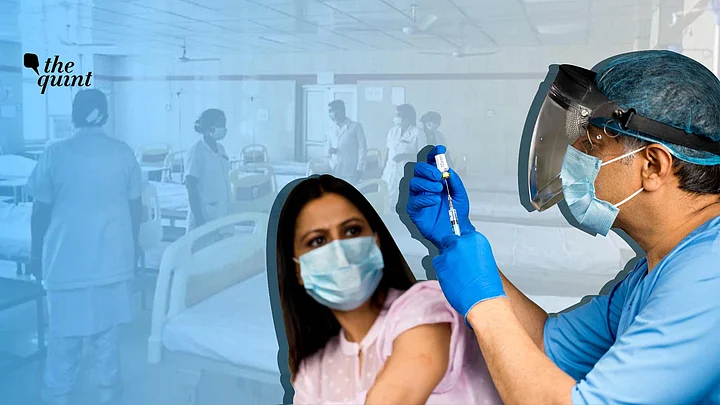Amid rising COVID-19 cases in Delhi, some experts, including Delhi health minister Satyendar Jain, have claimed that the latest wave to hit the capital will peak around 15 January, after which cases are expected to go down.
However, Delhi on Thursday, 13 January, reported 28,867 new COVID-19 cases and 31 deaths due to the viral disease. A day before, on Wednesday, Delhi logged 27,561 fresh COVID cases, which is a 29 percent rise in the last 24 hours and the highest number of cases recorded in single day since April 2021. The positivity rate touched 26 percent, which was the highest in seven months.
However, experts say there is a silver lining in sight.
Jain told NDTV that cases in the city are expected to peak in the coming days. He said, "I think that cases will peak in a day or two. This week, we will certainly see a peak. And after that, it should start going down."
Is there any basis behind the minister's claims? Dr Gautam Menon, professor of physics and biology at the Ashoka University, told The Quint, "According to our model, cases should peak fairly soon. Delhi can expect cases to peak around 16-17 January."
He added, "Roughly speaking, all over the country, the peak is expected around 20 January to 10 February. Bigger cities can expect to see cases peak a little earlier."
"The cases have been increasing fast. Every two days, the rate is doubling."Professor Gautam Menon
He said that the findings are based on data, extrapolating information, and looking at trends in other countries such as South Africa and the United Kingdom.
There are a few complexities, and hence there will always be a few uncertainties, he said. Regarding the government guidelines on testing only symptomatic and high-risk people, he said that this might lead to a few fluctuations. Yet, he says that it is accounted for because the focus is on how many have tested positive from amongst all those that got tested.
Fewer Hospitalisations Than the Previous Wave
Dr Chandrakant Lahariya, epidemiologist, public policy, and health systems expert, said that there could be a higher number of confirmed cases than those being reported, but there is no need to panic as the hospitalisations have remained low.
He said, "The quotes from the hospitals tell us that majority of those who have been hospitalised in Delhi, are those who were not vaccinated or partially vaccinated."
While the total number of cases would have been higher if all were getting tested, the new government guidelines on testing has meant that the absolute numbers are lower.
"The numbers might be higher but the hospitalisations are lower. After this wave dies down, we might not see numbers as low as we saw in December. The base line will be higher. Yet, I am confident that the pandemic will be over at some point. And that it will turn endemic."Dr Chandrakant Lahariya
Between January 1 and 12, the number of hospitalisations have gone up from 247 to 2363. On January 12 deaths touched 40. On May 3 last year, when the highest number of deaths was recorded, 20,142 hospital beds were occupied. Back then, the number of beds available were 21,477.
What the Data Reveals
Looking at numbers from the second wave in Delhi, it becomes clear that it took much longer for the cases to peak, and longer for the cases to go down.
From 10 April to 16 April, 2021, we saw the positivity rate increase from 10.21 percent to 19.69 percent. This year, we saw the positivity rate increase much more rapidly. The positivity rate went up from 8.37 percent on 4 January to 15.34 percent in a span of two days.
In the first 11 days of January, the number of positive cases in Delhi went up from 2,716 to 21,259. In April last year, the maximum number of cases recorded in a day was around 28,000. But it took longer for the cases to increase that drastically.
Professor Menon said, "This time around, the case rise is much faster because the variant is more transmissible. The graph is steeper, but the comedown would be much quicker, even if the cases might be more."
The deaths, too, were much higher during the second wave in Delhi. On 3 May, 2021, 18,043 new cases and 448 deaths were reported, the highest that Delhi has seen so far. The positivity rate that day was 29.56 percent.
Around the time that the cases had touched 20,000 last year, an oxygen crisis broke out in the city. Hundreds of people were left running from pillar to post, in search of hospitals, beds and oxygen across the capital.
This year, while the deaths are gradually increasing, the rate of increase is much slower than the surge in the number of cases.
SUTRA, a mathematical model developed by scientists at IIT-Kanpur and IIT-Hyderabad to track the COVID-19 curve in India, predicts that Delhi would peak around 35,000 to 70,000 cases in a day, around 15 January.
Despite the silver lining, Manindra Agrawal, one of the scientists that run SUTRA, said on Twitter, "Overall, this wave appears manageable due to low hospitalisation rates. Of course, things could change in the next couple of weeks. Also, there may be localised shortages of beds. So, proper care and planning is warranted."
(At The Quint, we question everything. Play an active role in shaping our journalism by becoming a member today.)
